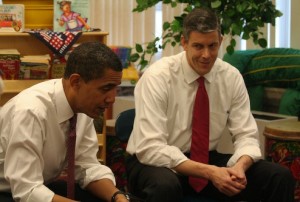Domestic, Education Quality, K-12, Public, Regulatory, Required, Student Loans - Written by Wired Academic on Tuesday, October 30, 2012 6:00 - 0 Comments
Stanford Professors Analyze Presidential Candidates’ Impact On Education Policy
What would a Romney or Obama presidency mean for schools and universities? At Stanford’s Education and Society Theme dorm recently, Hoover Fellow Eric Hanushek and School of Education Professor Emeritus Michael Kirst waded through the candidates’ proposals.
By Max McClure, Stanford News Service
Education briefly took center stage at the second presidential debate, with Republican candidate Mitt Romney and Democratic President Barack Obama trading jabs over school budgets and teaching jobs. And with debates about college tuition, K-12 funding, teachers unions and a swarm of other issues still raging, there’s no question that education issues will fill the plate of whichever candidate wins the Oval Office.
But overall, education policies have been dancing at the margins of this year’s political contest. What would a Romney or Obama presidency mean for schools and universities?
Last Thursday, Oct. 25, Stanford’s EAST (Education and Society Theme) House turned the spotlight on the candidates’ education policies. Eric Hanushek, the Paul and Jean Hanna Senior Fellow at the Hoover Institution, and a prominent figure in the economic analysis of education, and Michael Kirst, professor emeritus of education and business administration, who currently is president of the California State Board of Education, engaged in a back-and-forth before a largely student audience.
The candidates have taken starkly different positions on certain issues, such as school vouchers, student grants and loans, and for-profit education. Overall, however, the speakers agreed that the differences were subtle.
“It’s hard to see much light between them,” said Hanushek.
The event, moderated by education Associate Professor Anthony Antonio, resident fellow in EAST House, was one of a semi-regular series of educational talks hosted by the dorm, which preferentially houses students who minor in education or otherwise study or have experience in the field.
College life
The realm of higher education has brought out some of the clearest divisions in the candidates’ policies.
Kirst pointed in particular to the Obama administration’s expansion of the Federal Pell Grant Program for higher education. The increase in student loan and grant funding, trumpeted by Obama during the debates, was enabled by the federal government forcing private banks out of the student loan market in favor of direct federal administration of loans.
Romney’s position on student loans has changed over time, but Kirst, a Democrat, said he was “nervous about Romney giving it back to the banks.”
Kirst also pointed to Obama’s interest in cracking down on for-profit colleges – a sector Romney supports.
Hanushek, however, viewed the issue as unimportant – more an example of Obama’s “explicitly anti-private” stance. “I don’t think tax status is that big a deal,” he said.
Kirst also cited Obama’s prioritizing of funding for community colleges and immigrant education as distinctions between the candidates, though Hanushek questioned whether Romney was, in fact, opposed to the initiatives.
Schoolyard funding
The exchange drove home a particular difficulty in comparing the candidates’ policies: While Romney has a long track record of education reform in Massachusetts, his campaign has thus far been short on details as to what his education policies would look like as president.
On the other hand, Obama’s education policies are better documented, but neither expert was particularly enamored of the administration’s centerpiece program, Race to the Top. The policy set states against each other in a competition for $4.35 billion in K-12 education funding. Intended to spark changes in state and local education, the policy required states to meet highly specific standards in areas including teacher evaluation, data management and charter school availability.
“Race to the Top showed that, with a relatively small amount of money, you could change states’ behavior,” said Hanushek. “Although I don’t know if I liked the changes very much.”
Hanushek and Kirst agreed that the areas Race to the Top focused on are important, though both rankled at the detail-oriented manner in which the program was actually applied.
“I doubt that Romney would be as prescriptive as Obama,” said Hanushek.
Searching for differences
Otherwise, Romney’s proposals for K-12 education have largely been similar to Obama’s. He has even praised elements of Race to the Top.
Republican-supported tax cuts could lead to budget shortfalls for schools, Kirst suggested. But proposed school funding between the two campaigns has been virtually identical.
The one exception is Romney’s support for vouchers – a favorite of Republicans since the Reagan era. A school voucher program, which would take the $15 billion in Title I that funds low-income school districts and distribute it to parents to potentially offset the cost of private education, “is the sort of thing that drives the Democrats crazy,” said Kirst.
But Kirst and Hanushek dismissed the issue as symbolic. Not only would it be unlikely to pass without a Republican supermajority, the amount of money involved is “kind of trivial,” said Hanushek. “The $900 you give to a parent doesn’t make a difference.”
Romney has also pointed to teachers unions’ support of Obama as another distinction. Both the National Education Association and the American Federation of Teachers have endorsed the Democratic candidate. Obama’s relationship with the organizations, however, has at times been less than congenial.
“Before Obama won the nomination in 2008, he went to the NEA and was booed,” said Hanushek. “They’ve subsequently retracted the booing. But that’s because they don’t have anywhere to go.”
Campus Buzz
We welcome Tips & Pitches
Latest WA Original Features
-
“Instreamia” Shakes Loose Moss By Launching Spanish Language Mini-MOOC
-
Jörn Loviscach: A German Math Teaching Sensation Emerges On YouTube & Udacity
-
Open University Enters Battle Of The MOOCs, Launches “FutureLearn”
-
Alvaro Salas As A Case Study In Crowd-Funding An Ivy-League Education
-
Jonathan Mugan: How To Build A Free Computer Within A Computer For Your Child
Paul Glader, Managing Editor
@paulglader
Eleni Glader, Policy Editor
Elbert Chu, Innovation Editor
@elbertchu
Biagio Arobba, Web Developer
@barobba
Contributors:
Michael B. Horn
@michaelbhorn
Derek Reed
@derekreed
Annie Murphy Paul
@AnnieMurphyPaul
Frank Catalano
@FrankCatalano
Ryan Craig
@UniVenturesFund
Jonathan Mugan
@JMugan
Terry Heick
@TeachThought
Alison Anderson
@tedrosececi
Ravi Kumar
@ravinepal

The Pulitzer Prize winning investigation newsroom digs into for-profit education.
-
Most Viewed
- Inside Ashford University: A former staffer talks to WiredAcademic
- Infographic: A History Of Information Organization From Stone-Age To Google
- Davos: 12-Year-Old Pakistani Prodigy Girl Talks About Her Online Learning
- Open University Enters Battle Of The MOOCs, Launches "FutureLearn"
- Pearson Llc + Google Expands LMS Business With "OpenClass" System
-
MARKET INTRADAY SNAPSHOT
- Education & Tech Companies We Follow
| APEI | 40.20 |  0.00 0.00 |  +0.00% +0.00% | ||
| APOL | 19.01 |  0.00 0.00 |  +0.00% +0.00% | ||
| AAPL | 460.16 |  0.00 0.00 |  +0.00% +0.00% | ||
| BPI | 10.74 |  0.00 0.00 |  +0.00% +0.00% | ||
| CAST | 0.11 |  0.00 0.00 |  +0.00% +0.00% | ||
| CECO | 4.08 |  0.00 0.00 |  +0.00% +0.00% | ||
| COCO | 2.40 |  0.00 0.00 |  +0.00% +0.00% | ||
| CPLA | 32.03 |  0.00 0.00 |  +0.00% +0.00% | ||
| DV | 30.69 |  0.00 0.00 |  +0.00% +0.00% | ||
| EDMC | 4.03 |  0.00 0.00 |  +0.00% +0.00% | ||
| ESI | 18.34 |  0.00 0.00 |  +0.00% +0.00% | ||
| GOOG | 792.89 |  0.00 0.00 |  +0.00% +0.00% | ||
| LINC | 6.20 |  0.00 0.00 |  +0.00% +0.00% | ||
| LOPE | 25.03 |  0.00 0.00 |  +0.00% +0.00% | ||
| PEDH | 0.45 |  0.00 0.00 |  +0.00% +0.00% | ||
| PSO | 18.51 |  0.00 0.00 |  +0.00% +0.00% | ||
| SABA | 8.61 |  0.00 0.00 |  +0.00% +0.00% | ||
| SCHL | 30.87 |  0.00 0.00 |  +0.00% +0.00% | ||
| STRA | 51.95 |  0.00 0.00 |  +0.00% +0.00% | ||
| WPO | 414.41 |  0.00 0.00 |  +0.00% +0.00% |
Domestic, For-Profit, Gainful Employment, Infographics, Personalized Learning, Private, Public, Required, Universities & Colleges - Jan 31, 2013 6:09 - 0 Comments
Infographic: To Get A Degree Or Not To Get A Degree? Here Is An Answer
More In For-Profit
- Ryan Craig: American Clampdown Forcing Forlorn For-Profit Colleges To Look Abroad
- How For-Profit Colleges Major In Marketing & Fail Education
- Infographic: A Graphical Profile Of Today’s Online College Student
- Infographic: A Comparison Of For-Profits v. Non-Profit Online College Data
- Opinion: How “Shareholder Value” Is Destroying For-Profit, Career Colleges
Cost of Education Domestic Education Quality Ethics For-Profit Friend, Fraud, or Fishy Gainful Employment Graduation Rates Legislation Minorities Opinion Recruitment Regulatory Required Retention Rates Student Loans Universities & Colleges
MOOCs, Required, Technology - Feb 16, 2013 10:04 - 1 Comment
MOOC Monitor: Must Reads This Week
More In Technology
- Infographic: Rise of the MOOCs
- Smart Cities Part II: Why DC Is The Planetary Hub Of Online Learning
- Five Questions: Polling EdTech Startup UnderstoodIt’s Liam Kaufman
- Infographic: The Future of Higher Education
- Anne Collier: Study Shows eBooks Gaining Larger Share & Boosting Overall Reading Habits
Domestic K-12 Parents Reading / Literature Required Technology
Cost of Education, Domestic, Early Childhood Education, Education Quality, Friend, Fraud, or Fishy, Legislation, Minorities, Parents, Public, Required - Feb 18, 2013 4:59 - 0 Comments
Important Early Questions Over Obama’s Early Childhood Program Ambitions
More In Friend, Fraud, or Fishy
- Should For-Profit Companies Manage K-12 Schools? A Skeptical Review
- A Letter To Sen. Tom Harkin About For-Profit Charter Schools
- Ryan Craig: American Clampdown Forcing Forlorn For-Profit Colleges To Look Abroad
- Opinion: The Problem With Deceptive Degree Aggregators In The Search For Online Courses & Degrees
- How For-Profit Colleges Major In Marketing & Fail Education
Domestic Education Quality Ethics For-Profit Friend, Fraud, or Fishy Graduation Rates Minorities Recruitment Required Retention Rates Universities & Colleges



Leave a Reply